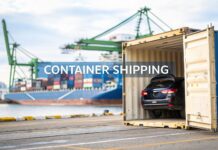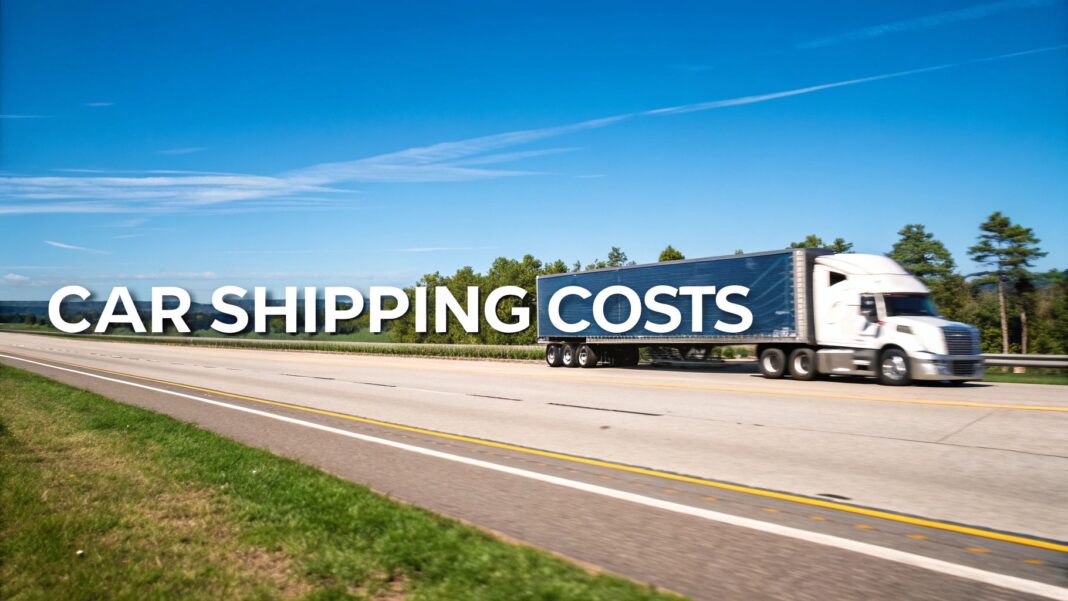
The cost to ship a car to another state typically falls between $600 for a shorter haul and $2,000 for a coast-to-coast move. The final price is determined by the total distance, your choice of transport carrier (open or enclosed), and your vehicle's size.
Your Quick Guide to Interstate Car Shipping Costs
Pinning down a firm price for shipping your car requires understanding the key variables. At its core, the price is driven by two main factors: how far your car is traveling and the level of protection you choose for the journey.
Think of it like booking a flight. A short trip in economy class is significantly cheaper than a first-class ticket across the country. The same principle applies here. An open carrier is the standard, most cost-effective option—it's the economy ticket for your car. In contrast, an enclosed carrier provides a fully-covered, premium transport, making it the first-class choice for classic, luxury, or high-value vehicles.
Gauging Your Initial Budget
To set a practical starting point, the average cost to ship a standard sedan within the U.S. in 2025 is around $650 for trips under 1,000 miles. As a general rule, you can expect to pay anywhere from $0.40 to $2.00 per mile.
Interestingly, the price-per-mile decreases as the distance increases. This makes longer, cross-country transports more efficient on a per-mile basis. You can learn more about how car shipping calculations are made and see a complete breakdown of all pricing factors.
Understanding the difference between carrier types is the most critical step in setting a realistic budget. Both options will get your car to its destination safely, but the price gap between them can be substantial.
Actionable Insight: Your choice between an open and enclosed carrier is the single biggest decision affecting your shipping cost, often creating a price difference of 40-60%. Open transport is the practical choice for daily drivers, while enclosed transport is the premium option for protecting valuable investments.
To see this difference clearly, here's a direct comparison of what you can generally expect to pay.
Average Costs for Open Vs Enclosed Car Shipping
| Distance Range | Open Carrier Cost | Enclosed Carrier Cost |
|---|---|---|
| 0-500 Miles | $500 – $800 | $700 – $1,100 |
| 500-1,500 Miles | $800 – $1,300 | $1,100 – $1,800 |
| 1,500+ Miles | $1,300 – $1,900 | $1,800 – $2,500+ |
As you can see, the choice has a significant impact. Our guide on car transport services offers more detail to help you decide which option is right for your vehicle and budget. Use these figures as a benchmark before we dive into the other variables that will fine-tune your final quote.
Breaking Down Your Car Shipping Quote
If you've ever compared two car shipping quotes for the same trip and wondered about the price difference, you're not alone. Pricing is not a simple formula; it's a dynamic calculation based on multiple factors. Similar to booking a flight, the cost isn't just about the distance—it's also influenced by the route's popularity, the time of year, and how far in advance you book.
The cost to ship car to another state operates on these same principles. Your final quote is a carefully calculated total based on several key variables. Once you understand these components, you can see exactly where your money is going and identify opportunities to save.
Let’s examine each piece of the pricing puzzle.
The Big Three Cost Drivers
While many small details can influence the final price, three major factors establish the foundation for nearly every shipping quote. These elements have the most significant impact on your cost right from the start. Grasping these will give you a solid baseline for what your shipment should cost.
This simple breakdown illustrates how these core factors build your final price.
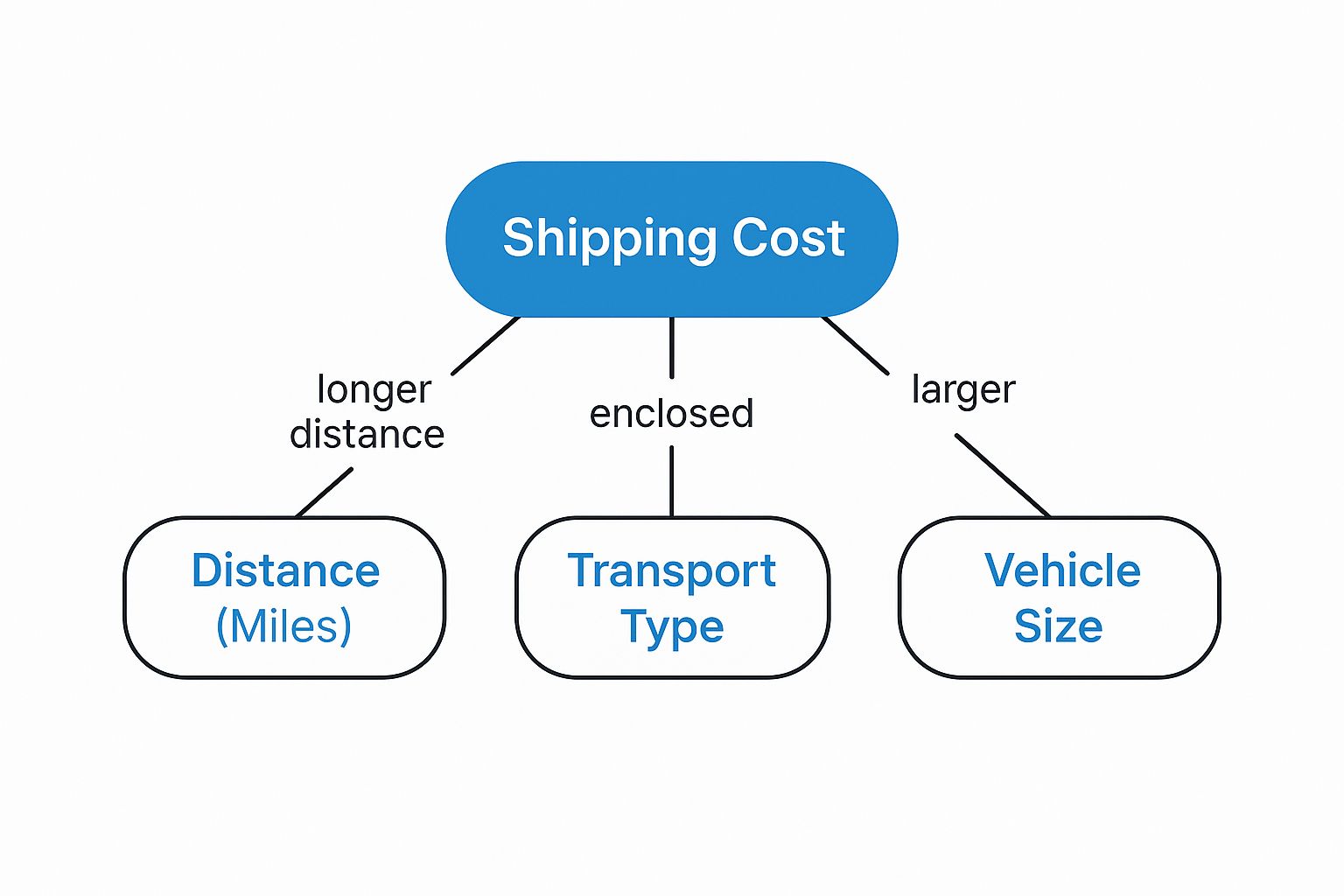
As shown, the distance, your vehicle’s size, and the type of transport you select are the cornerstones of your final payment.
Let's explore each one:
-
Total Distance: This is the most straightforward factor. Longer trips require more fuel, more driver hours, and more wear on the truck. While the total cost increases with mileage, the cost-per-mile often decreases on long-haul routes as the carrier maximizes operational efficiency.
-
Vehicle Size and Weight: A larger, heavier vehicle occupies more space and consumes more of a carrier’s weight allowance. Shipping a large Ford F-150 will cost more than a compact Honda Civic because the truck takes up space that could otherwise fit another car. You must also disclose any modifications like oversized tires or a lift kit, as these can increase the price.
-
Transport Type (Open vs. Enclosed): As noted earlier, this choice significantly affects the cost. Open carriers are the industry standard—they are the most common and economical option, but your car is exposed to weather and road debris. Enclosed carriers provide complete protection inside a sealed trailer. This is the preferred method for luxury, classic, or high-value cars, but this premium service typically costs 40-60% more.
Beyond the Basics: Seasonal and Route Factors
Once the "big three" are determined, other fluid variables based on supply and demand come into play. This is why quotes for the same route can fluctuate throughout the year.
The price per mile for car shipping in the U.S. can swing dramatically, with documented rates falling anywhere between $0.53 and $2.30 per mile. This significant variance underscores how much factors like seasonality and route popularity can affect your final quote. You can explore more about these auto transport industry statistics to see the full picture.
Timing your shipment is a smart way to manage your budget.
-
Seasonality and Demand: The auto transport industry has distinct peak seasons. Summer is busy with family relocations, and the end of the year sees a holiday rush. The annual "snowbird" migration, where people move cars south for the winter, also creates high demand. Shipping during these periods will cost more than booking in the quieter fall or spring months.
-
Route Popularity: Carriers operate most efficiently on popular routes. Major interstate corridors between large cities (e.g., Los Angeles to New York) are highly trafficked by trucks, which increases competition and lowers prices. Conversely, if you need a car shipped to or from a remote, rural location, it will cost more. The driver must detour from their main route, which consumes extra fuel and time, and that cost is passed on to you.
How to Calculate Your Estimated Shipping Cost
Budgeting for car shipping doesn't have to be guesswork. While every quote is specific, you can create a surprisingly accurate estimate yourself. By starting with a baseline rate and adjusting for the key factors we've discussed, you can develop a solid budget before requesting official quotes.
This exercise provides more than just a number; it gives you control. When you have a realistic idea of what the cost to ship a car to another state should be, you can evaluate official quotes with more confidence.
Let's walk through the steps to build your own estimate.
Step 1: Start with the Base Rate Per Mile
Distance is the foundation of any shipping quote. The cost-per-mile is not linear—the longer the trip, the less you typically pay per mile. This is because fixed costs like loading and unloading are spread over a greater distance. Short trips are cheaper overall, but their per-mile rate is higher.
Use this guide as a starting point:
- Short Hauls (Under 500 miles): $1.00 to $1.50 per mile.
- Medium-Range (500-1,500 miles): $0.75 to $1.25 per mile.
- Cross-Country (Over 1,500 miles): $0.50 to $0.90 per mile.
Let's estimate shipping a car 1,200 miles. This falls into the medium-range category, so we’ll use $1.00 per mile as our base.
Base Cost Calculation: 1,200 miles x $1.00/mile = $1,200
Step 2: Adjust for Your Vehicle’s Size
Next, consider your vehicle. The industry baseline is a standard four-door sedan. Larger vehicles cost more because they take up more space and weight on the truck.
- Standard Sedan (e.g., Honda Accord): $0 (this is our baseline)
- Mid-Size SUV or Small Truck (e.g., Ford Explorer): Add $100 – $200
- Large SUV or Full-Size Truck (e.g., Chevy Suburban): Add $200 – $400+
For our 1,200-mile trip, let's assume we're shipping a Mid-Size SUV. We will add a conservative $150 to our running total.
Updated Estimate: $1,200 (Base) + $150 (SUV Fee) = $1,350
Step 3: Consider Seasonal and Route Factors
Now, factor in when and where you're shipping. Moving during a high-demand period—like summer or the winter "snowbird" season—will increase the price. The route also matters. A carrier can operate more profitably on a popular, high-traffic route between major cities than on a trip to a remote town.
- Peak Season Surcharge: Add $100 – $300
- Rural Delivery Surcharge: Add $100 – $200
Let’s say our move is in July (peak season), but the route is between two major hubs, so we can avoid the rural fee. We’ll add a $200 seasonal adjustment.
New Total: $1,350 (Current Estimate) + $200 (Seasonal Fee) = $1,550
This is the same logic online calculators use. They take these variables and compute the numbers for you.
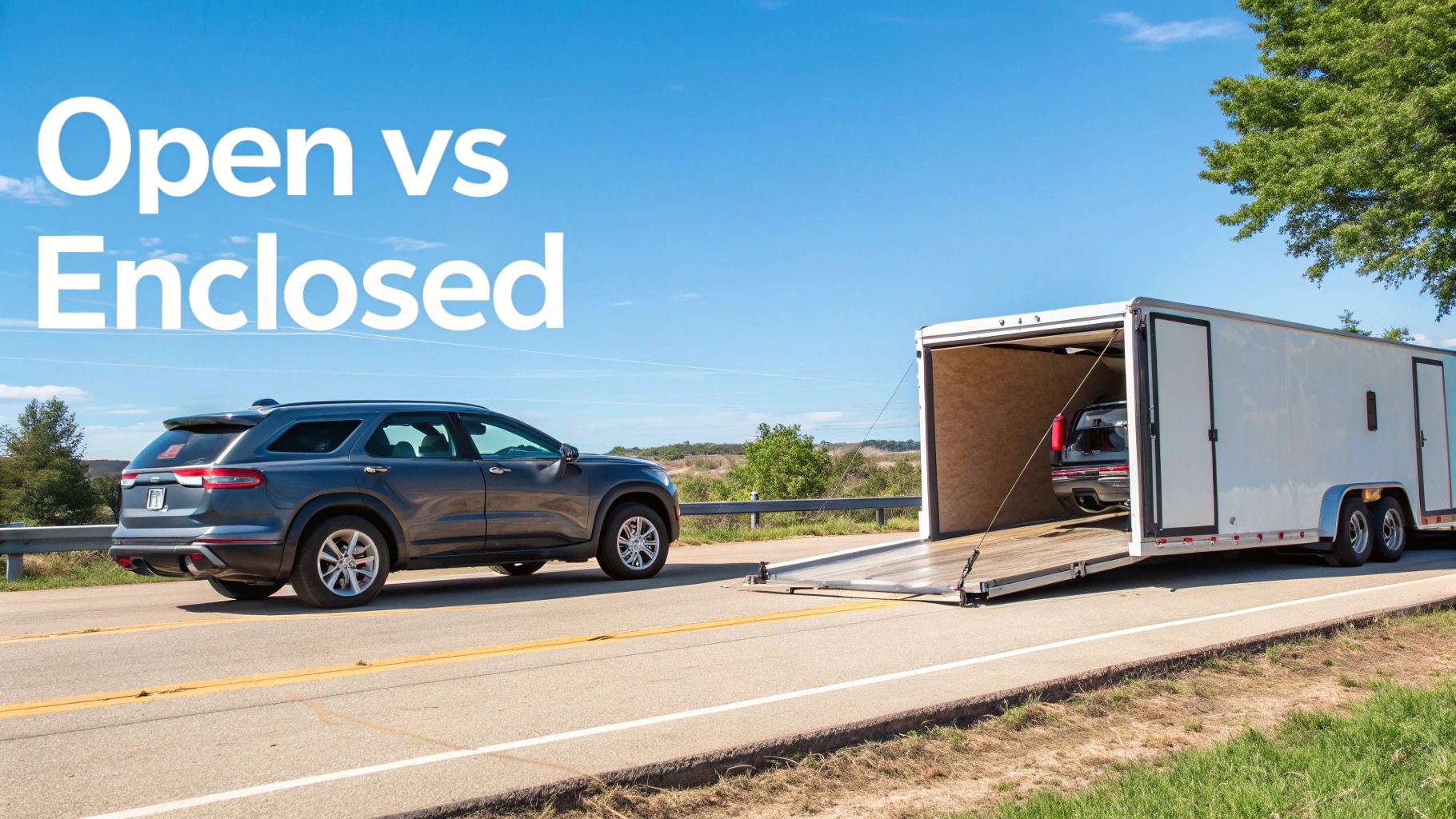
These tools are excellent for getting a quick estimate by bundling factors like distance, vehicle type, and transport options.
Step 4: Account for Optional Services and Fees
Finally, consider any special requirements. If you need your car delivered quickly, expedited shipping can add $250 or more. For a classic or luxury car requiring an enclosed carrier, expect the total cost to increase by 40-60%.
For our example, a standard open carrier and a normal delivery window are sufficient, so no extra charges apply.
This brings our final estimated cost for shipping a mid-size SUV 1,200 miles during peak season to $1,550.
With a realistic benchmark established, you are prepared to request official quotes. You can easily get a free shipping quote to see a precise price tailored to your exact shipment.
Real-World Shipping Costs and Scenarios
Understanding the components of a shipping quote is useful, but seeing them applied to real-world scenarios makes the information practical. The true cost to ship a car to another state becomes clearer when you examine how different situations affect the final price.
Let’s review some common shipping examples to see how variables like distance, vehicle size, and carrier choice interact to determine the final cost. Use these scenarios as a reference point for your own budget planning.

Scenario 1: The Student's Short-Haul Sedan Move
A college student is moving a standard Honda Civic from Phoenix, Arizona, to Los Angeles, California. This is a common, short route of about 375 miles. To stay within a tight budget, they opt for an open carrier. They are also flexible on timing, shipping in October during the "shoulder season" to avoid peak prices.
Here's the cost breakdown:
- Vehicle Type: Standard sedan (Honda Civic), no additional size fees.
- Distance: A short 375-mile trip on a major interstate.
- Carrier Choice: Open carrier, the most economical option.
- Seasonality: Shipping in the fall avoids the summer rush surcharge.
Estimated Final Cost: $550 – $700
This scenario demonstrates how to minimize costs. A standard car on a popular, shorter route, combined with flexible timing, can be very affordable.
Scenario 2: The Family's Cross-Country SUV Relocation
A family is relocating from Chicago, Illinois, to Orlando, Florida, and needs to ship their Ford Explorer, a mid-size SUV. This is a longer journey of approximately 1,180 miles. The move is scheduled for late June, during the peak season for both moving and auto transport. They choose an open carrier to manage costs but require door-to-door service for their primary family vehicle.
Let's see how the numbers add up:
- Vehicle Type: Mid-size SUV, adding about $150 for extra size and weight.
- Distance: A long-haul trip of over 1,000 miles.
- Carrier Choice: Open carrier to balance other cost factors.
- Seasonality: Peak summer timing adds a seasonal fee of around $200.
If you're planning a similar move, our guide on the cost to ship a car to Florida offers a deeper dive into this popular route.
Estimated Final Cost: $1,100 – $1,350
Scenario 3: The Enthusiast's Prized Classic Truck
A classic car collector needs to transport a restored 1968 Chevrolet C10 pickup from a small town in Oregon to a car show in Dallas, Texas—a trip of about 2,100 miles. Protecting this irreplaceable truck from weather and road debris is the top priority, making an enclosed carrier the only viable option. Additionally, the remote pickup location requires a significant detour from the main interstate, incurring an extra fee.
Breaking down this specialized transport:
- Vehicle Type: An oversized, classic truck.
- Distance: A cross-country haul of 2,100 miles.
- Carrier Choice: Enclosed carrier, costing 40-60% more than an open one.
- Route: Rural pickup adds a surcharge of approximately $150.
Estimated Final Cost: $2,400 – $2,800
This situation shows how specialized needs, such as the protection of an enclosed trailer and a remote pickup, can significantly increase the cost. For a valuable asset, this peace of mind is often worth the investment.
Sample Car Shipping Scenarios and Costs
This table provides a quick snapshot of how different factors combine to create a final price estimate.
| Shipping Scenario | Distance | Vehicle Type | Carrier Choice | Estimated Final Cost |
|---|---|---|---|---|
| Student's Move | 375 Miles | Standard Sedan | Open Carrier | $550 – $700 |
| Family Relocation | 1,180 Miles | Mid-Size SUV | Open Carrier | $1,100 – $1,350 |
| Classic Truck Transport | 2,100 Miles | Classic Pickup | Enclosed Carrier | $2,400 – $2,800 |
As demonstrated, there is no single answer to "how much does it cost?" Your specific requirements will always determine the final quote.
Proven Strategies to Reduce Your Shipping Costs
Understanding the factors that influence the cost to ship car to another state is the first step. The next is implementing strategies to save money. With careful planning, you can significantly reduce the final price without compromising on safety or service quality.
Think of it like booking a vacation: traveling during the off-season and being flexible with dates can lead to better deals. The same logic applies to auto transport. A little foresight can result in substantial savings.
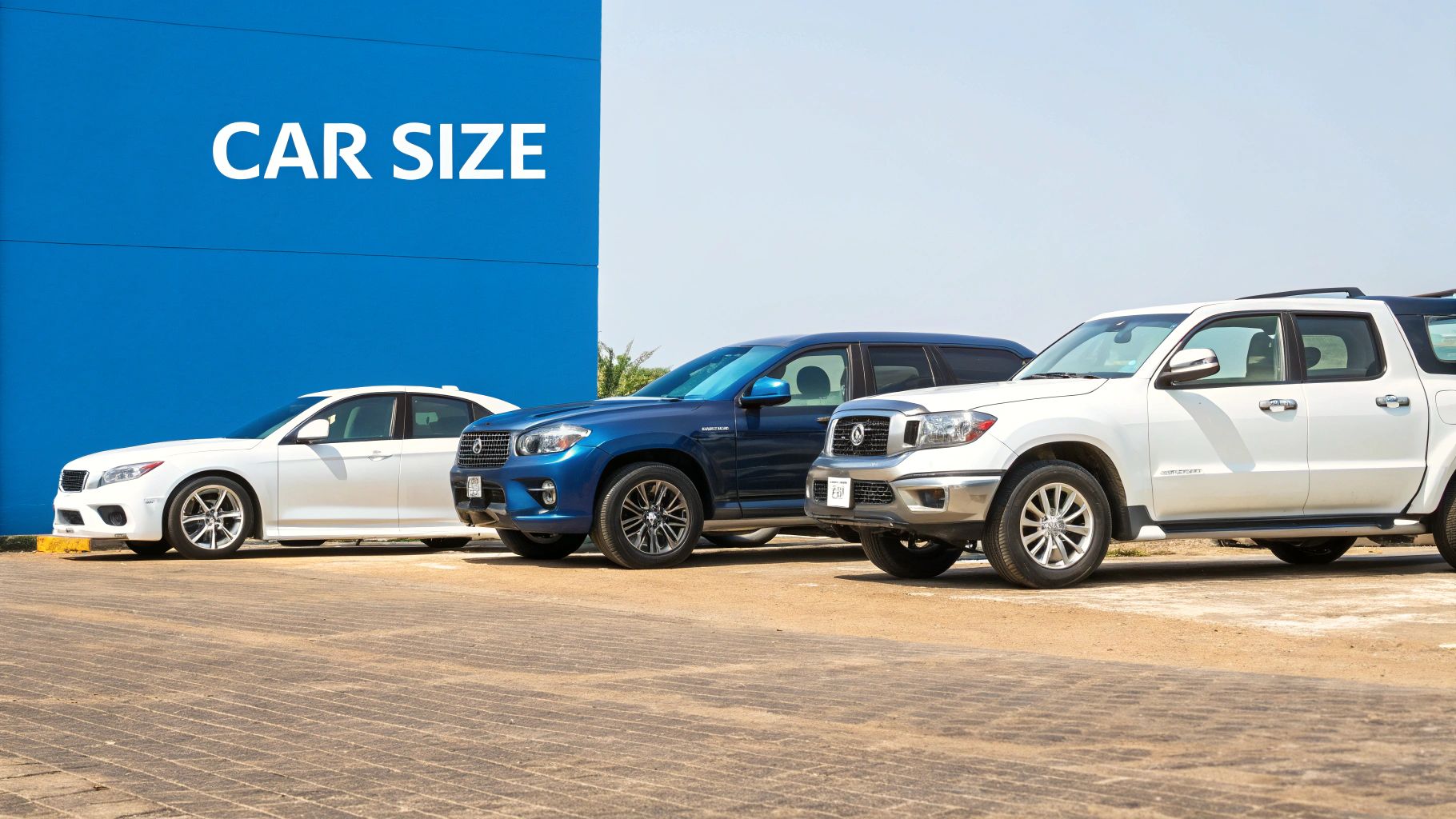
Be Flexible with Your Timing
One of the most effective ways to lower your bill is to avoid being locked into a specific date. The auto transport industry has peak seasons, such as summer months and major holidays. Shipping your car during these times is like booking a flight on Christmas Eve—you will pay a premium.
If your schedule allows, plan your shipment for the quieter "shoulder seasons" in the fall or spring. You could save $100 to $300 by avoiding the summer rush or winter snowbird migration. Providing the transport company with a wider pickup window (e.g., a week instead of a single day) allows them to fit your vehicle onto a route more efficiently, often resulting in a lower price.
Choose Open Transport for Standard Vehicles
Enclosed transport provides maximum protection but comes at a high price. For the majority of vehicles—daily drivers, family sedans, or SUVs—an open carrier is the most practical choice. It is the industry standard because it is safe, reliable, and significantly cheaper.
Actionable Insight: By choosing an open carrier over an enclosed one, you can reduce your shipping cost by as much as 40-60%. Unless you are shipping a priceless classic, a high-end luxury car, or another irreplaceable vehicle, the savings from open transport are too significant to ignore.
This is arguably the single most impactful decision on your final quote. Professional operators of modern open carriers are experts at securing vehicles properly, providing the same level of care you should expect from any transport service.
Consider Terminal-to-Terminal Delivery
Door-to-door shipping offers undeniable convenience, but this service adds to the cost, especially if you live in a rural or hard-to-reach area. Large transport trucks are not designed for narrow residential streets, and the extra time and mileage required for direct delivery are factored into your price.
An alternative is terminal-to-terminal shipping. You drop your car off at a secure lot in a major city and pick it up from a similar facility near your destination. This saves the driver significant time, as they can load and unload multiple cars at one central point. These savings are passed on to you, often reducing your quote by another $50 to $150.
Get Multiple Quotes to Compare
Never accept the first price you receive. The car shipping industry is competitive, and quotes for the same trip can vary significantly. Make it a rule to get quotes from at least three different reputable companies. This will give you a realistic benchmark for what you should be paying.
This process isn't just about finding the lowest number; it also helps you identify red flags. A quote that is dramatically lower than others could indicate hidden fees or substandard service. Comparing offers side-by-side allows you to find the optimal balance between a fair price, a great company reputation, and the services you need.
Costly Mistakes to Avoid When Shipping Your Car
A successful car shipping experience involves more than just getting a low price—it's about avoiding hidden costs and potential frustrations. Understanding the common pitfalls that can inflate your bill or cause delays will simplify the process of determining the cost to ship a car to another state.
By being proactive, you can ensure the entire process is smooth and predictable. Let's review the most common mistakes and how to avoid them.
Overlooking the Insurance Details
Assuming all insurance coverage is the same is a significant risk. While every carrier is legally required to have cargo insurance, the coverage amount and terms can vary dramatically. Failing to verify these details could leave you with inadequate protection in the event of an incident.
Actionable Step: Before booking, always request a copy of the carrier's insurance certificate. Confirm two critical details:
- Coverage Amount: Is the policy limit sufficient to cover the full value of your vehicle?
- Deductible: If a claim is necessary, what is your out-of-pocket responsibility?
This simple action provides both peace of mind and essential financial protection.
Don't be misled by the term "fully insured." A carrier's policy must cover all vehicles on the trailer. If a major accident occurs and the total value of the cars exceeds the policy limit, you may not receive full compensation.
Failing to Document Your Car's Condition
Skipping a thorough pre-shipment inspection can lead to a "he said, she said" dispute if your car arrives with new damage. Without clear proof of your vehicle's condition before it was loaded, it is nearly impossible to win a damage claim.
Actionable Step: Create your own detailed record. Just before pickup, take clear photos and videos of your car from every angle, both inside and out. Zoom in on any existing scratches, dings, or dents. During the driver's inspection, verify that their notes on the Bill of Lading (BOL) match your assessment before you sign. This document is crucial if a problem arises.
Not Disclosing Vehicle Modifications
Forgetting to mention a lift kit, oversized tires, or a roof rack can result in surprise fees or even a refusal of service at pickup. Carriers plan their loads based on standard vehicle dimensions and weights. Any modification that makes your car taller, wider, or heavier can disrupt their logistics.
Actionable Step: Be completely transparent about all modifications when requesting quotes. This ensures the price you receive is accurate and that the carrier sends a truck capable of accommodating your vehicle, preventing costly, last-minute complications.
Your Top Car Shipping Questions Answered
https://www.youtube.com/embed/8-RECmzyh2g
Even after estimating the cost to ship car to another state, some questions are common. Here are answers to the most frequently asked questions to help you book your transport with confidence.
What Kind of Insurance Is Included?
By law, every licensed auto transporter must carry cargo insurance. This policy serves as a safety net for your vehicle while it is on their truck, covering potential damage that may occur during transit.
However, not all policies are the same. Coverage limits and deductibles can differ significantly between carriers. Actionable Step: Always request a copy of their insurance certificate before booking. This is the only way to confirm that your car's value is fully protected and to understand your potential out-of-pocket costs if a claim is necessary.
Does My Car’s Condition Affect the Price?
Yes, but primarily only if your car is inoperable. If your vehicle does not run, the driver cannot simply drive it onto the trailer. They will need special equipment, such as a winch, to load and unload it safely.
This additional labor and equipment typically add $100 to $200 to the total cost.
Actionable Insight: The standard quote assumes your car runs and drives. Be upfront about a non-running vehicle to receive an accurate price and avoid unexpected fees on pickup day.
How Far in Advance Should I Book?
To secure the best price and have the most flexibility, book your shipment at least two to three weeks in advance. This lead time gives the transport company a better opportunity to schedule your vehicle on the most efficient route, and the resulting cost savings are often passed on to you.
While last-minute shipping is sometimes possible, it will almost always be more expensive. A little planning is your most effective strategy for keeping costs down and ensuring a smooth process.
Ready to move forward with confidence? The experts at We Will Transport It provide transparent quotes and manage every detail of your vehicle's journey, ensuring a safe and predictable shipping experience. Get your free, no-obligation quote today at https://www.wewilltransportit.com.




